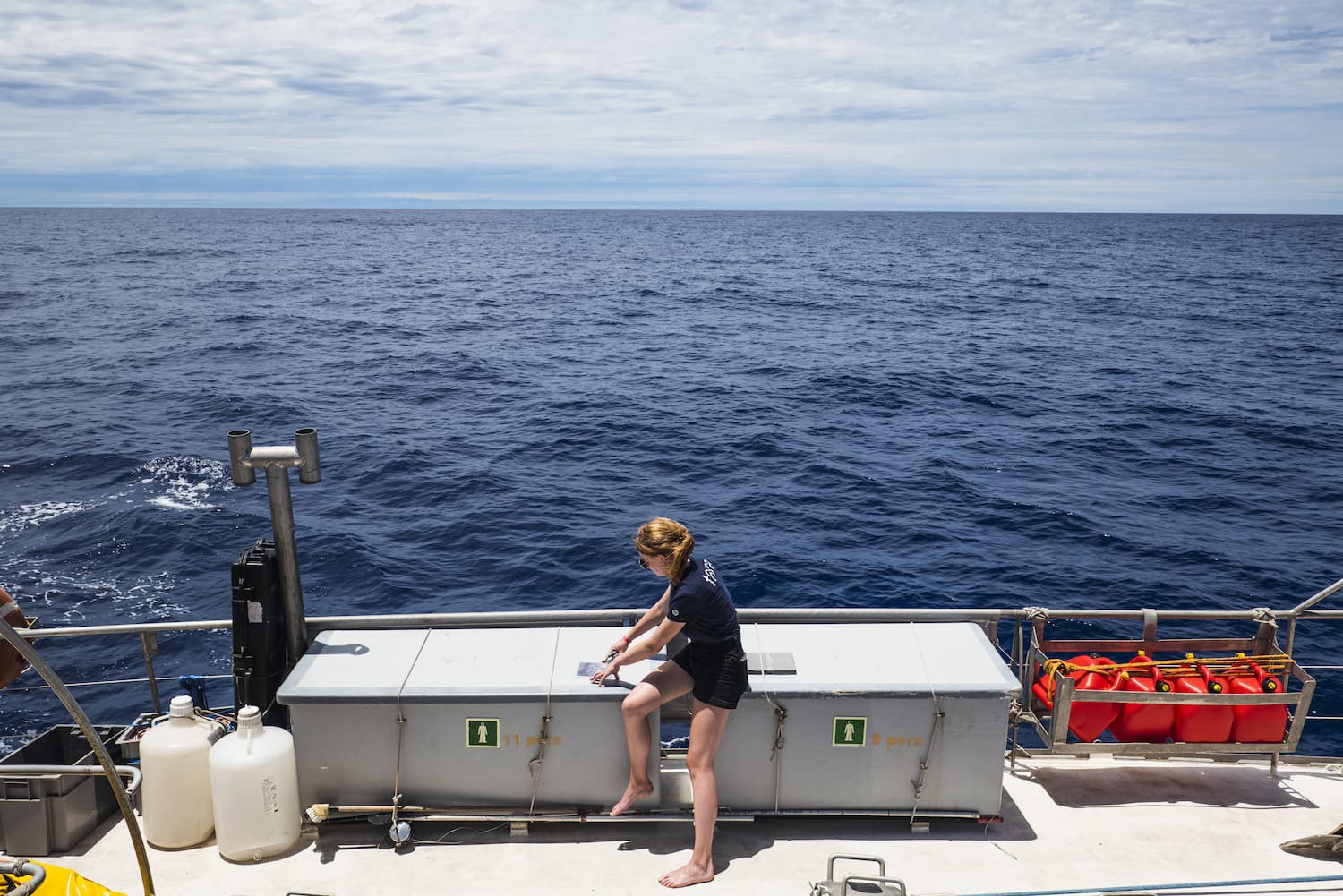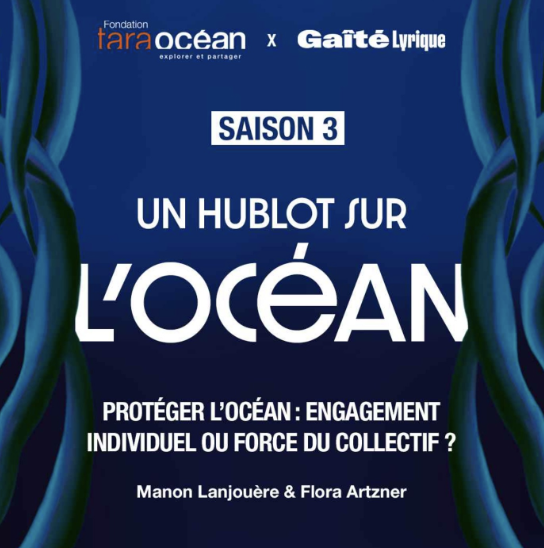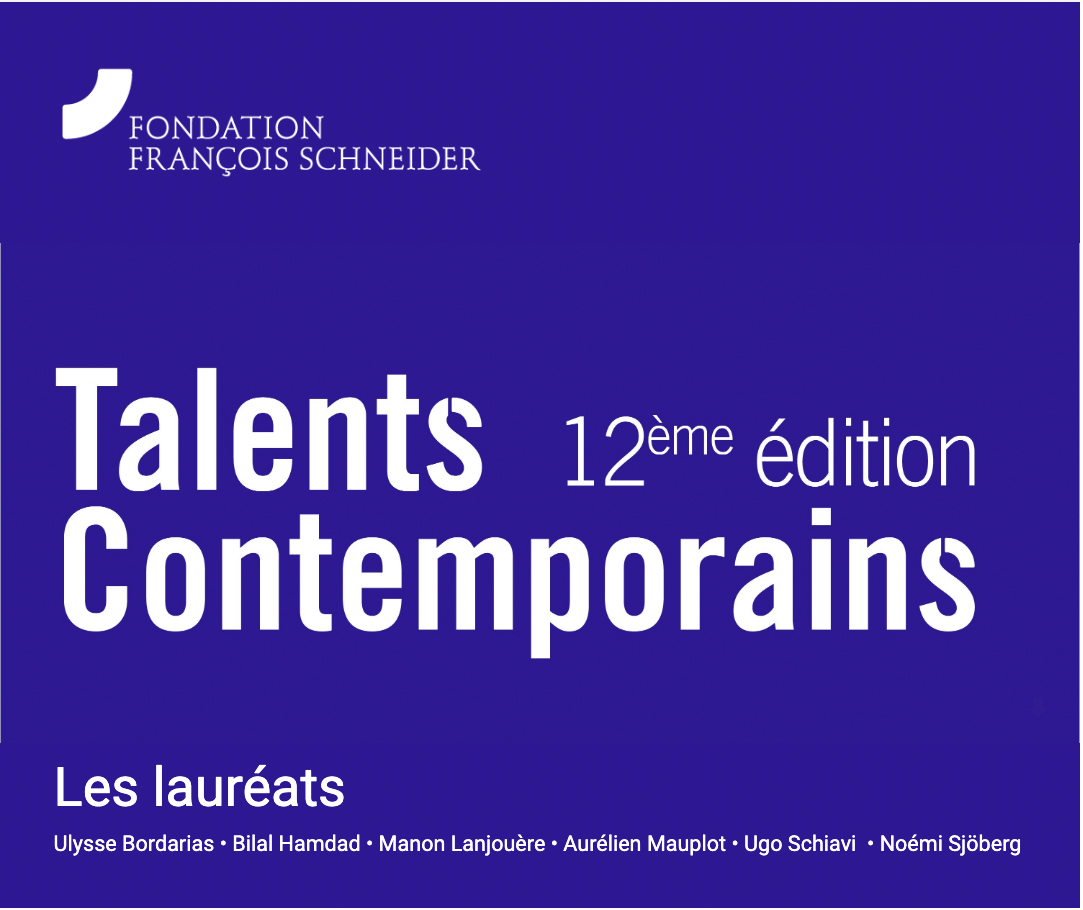Manon Lanjouère
News
︎ On going exhibitions
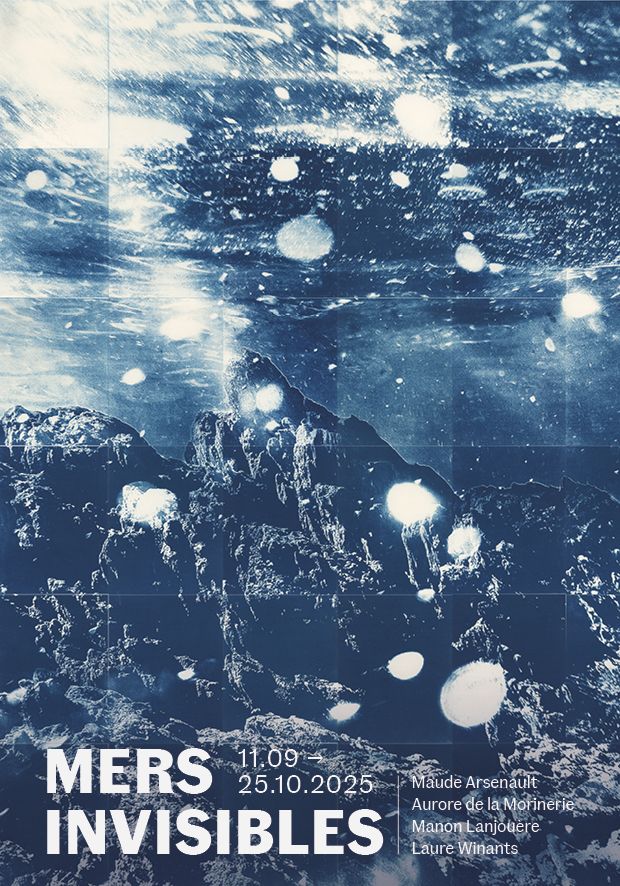
︎“Mers Invisibles” group show at Galerie Echo 119, 1 rue des Minimes 75003 Paris, France
11th September - 25th October 2025
opening on the 11th September 7- 9 pm
︎Daegu Photo Biennial “The Pulse of Life”, 18th September - 16th November, Daegu Arts Center, KOREA, Les Particules
︎8th Biennial of Architecture and Urban Planning of Caen-Normandie "Ondes sensibles", 1st October - 21st November, Caen, Les Particules

Interview as part of the Nice Biennial of Arts and Oceans and the 3rd United Nations Conference on the Ocean (UNOC3) from 9 to 13 June 2025.

Press
"Les Midis d’été" on France Culture, presented by Chloë Cambreling, alongside Hélène Guenin, co-curator of the Nice Biennial of Art and the Ocean, and Ugo Schiavi, artist.
Portrait in Twist Mer & plage : vagues d’inspirations ?
Kronen Zeitung Magazin, 29th august 2025, p 44 - 45, Les Particules

Libération, 6th June 2025, Les Particules
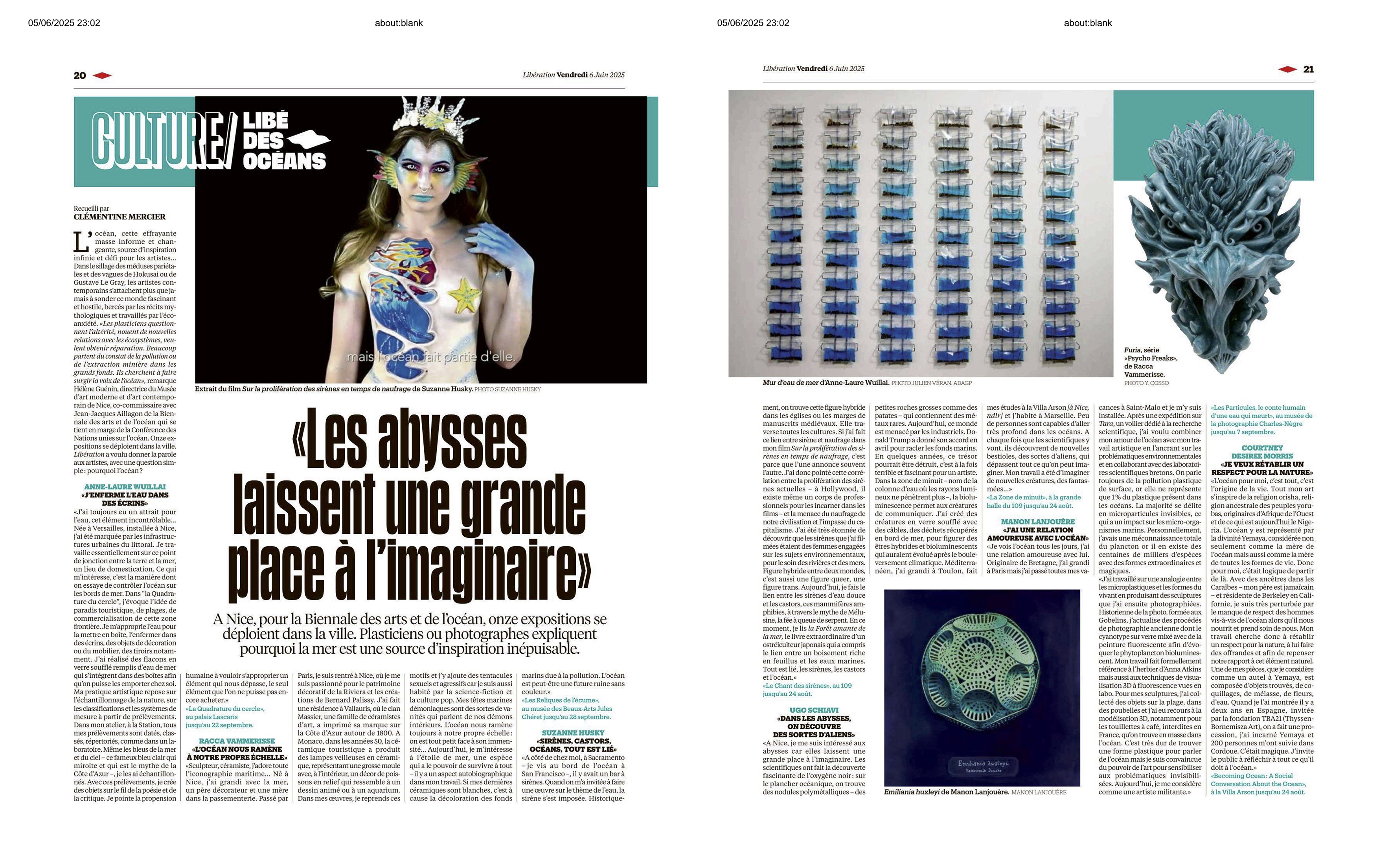
Connaissance des Arts n°June 2025, p104-105, Les Particules
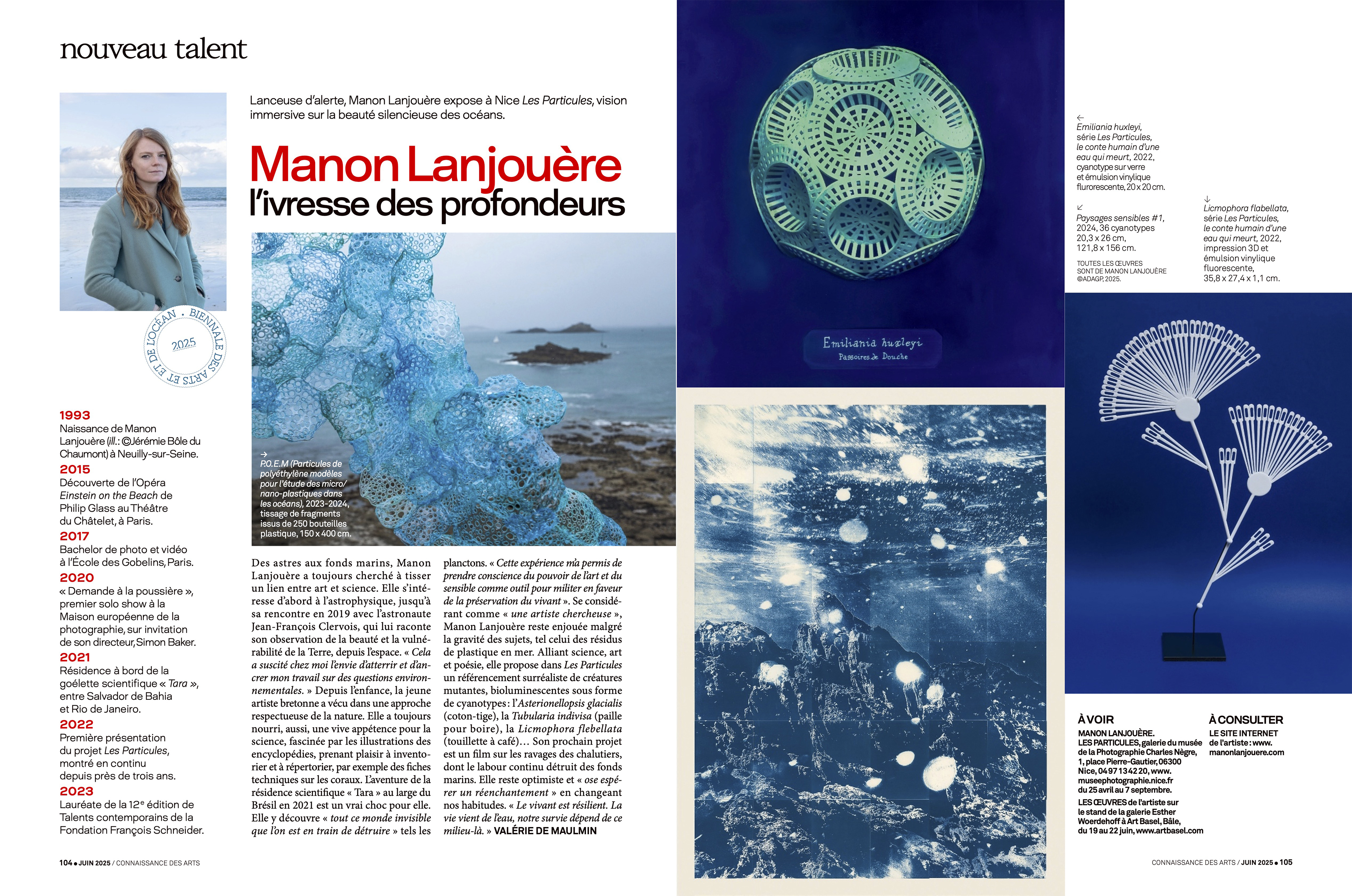
Süddeutsche Zeitung Magazin, number 18, 2 mai 2025, p 30 - 35, Les Particules
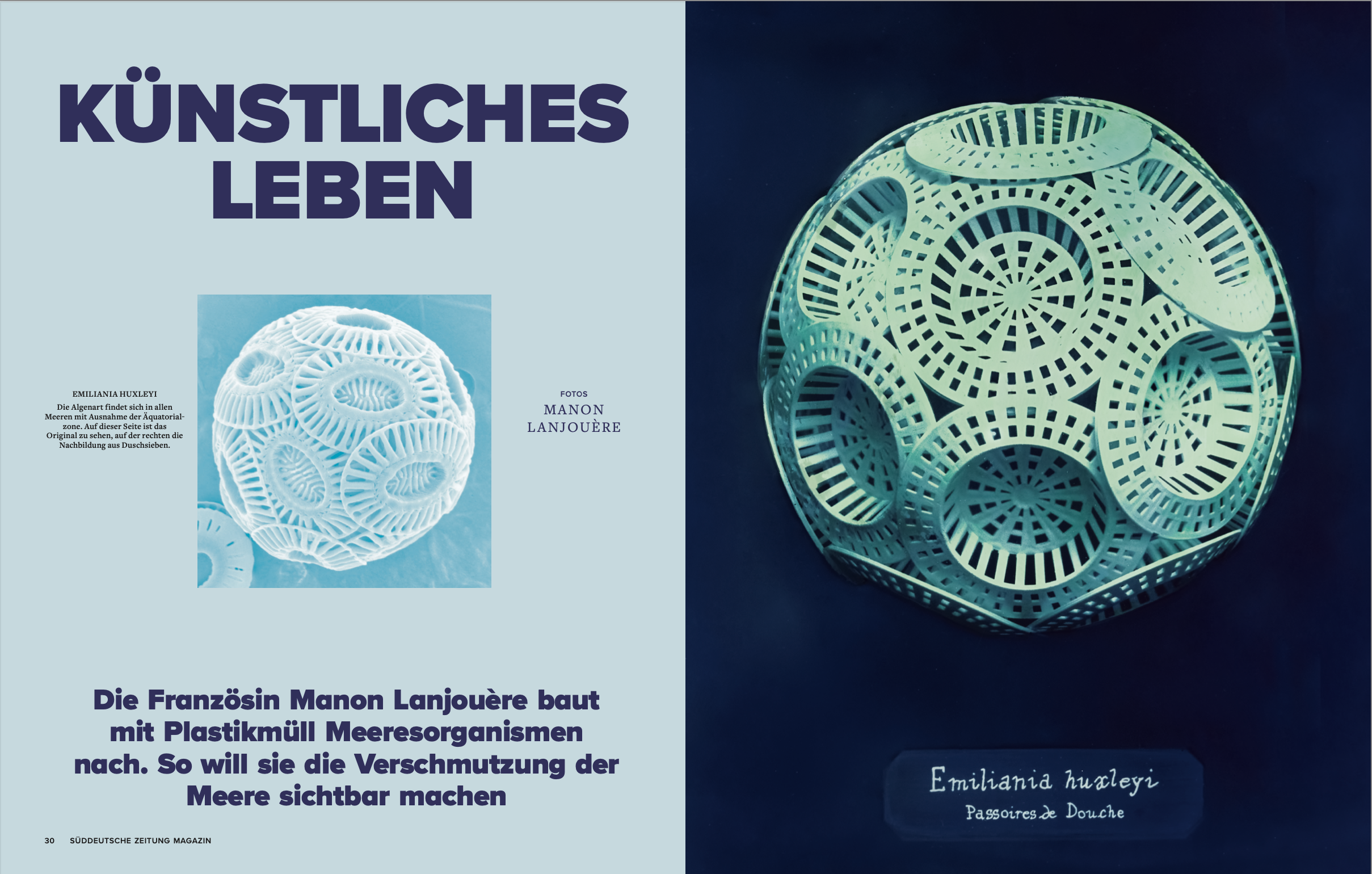



Interview as part of the 12th edition of Contemporary Talents of Fondation François Schneider
Interview : Sarah Guilain
Réalisation video : Émilie Fux
Sound mix : Guillaume Zenses
Captation of the exhibition in Vannes : Jérémie Bôle du Chaumont
Shooting location : Saint-Malo, France

Press
interview with Ingrid Bauer for Hum Média

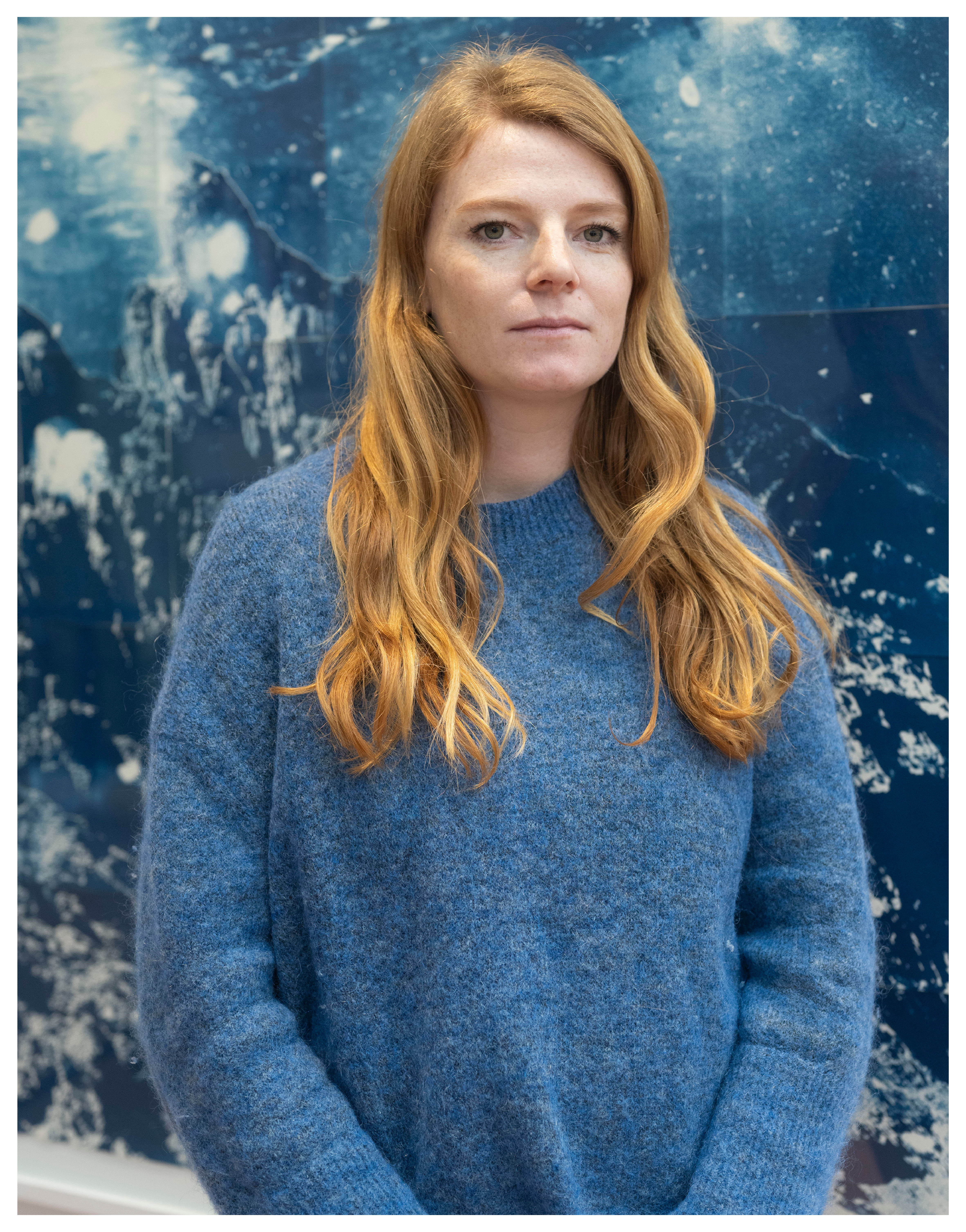

Throwback on my soloshow in Le Kiosque in Vannes, FRANCE
Vidéo : Jérémie Bôle du Chaumont
Art work, text and voice : Manon Lanjouère
Interview for Vannes City

Podcast Un Hublot sur l’Océan S3 ep 4 Protéger l’Océan : Engagement individuel ou force du collectif ?
Protecting the Ocean: Individual commitment or collective strength?
It is the combination of billions of individual actions and collective efforts that will create a significant impact for the preservation of the Ocean and our planet. Making a commitment and inspiring others to follow is a personal choice, but also a civic one, in favour of a more sustainable world for future generations. Artists and sportswomen, they have chosen to use their discipline to change our relationship with the Ocean and mobilise people around our shared responsibility. Find out in this episode how individual commitment can drive collective efforts. We look at visual artist Manon Lanjouère and wingfoiler Flora Artzner.
Recorded in french ︎
Protecting the Ocean: Individual commitment or collective strength?
It is the combination of billions of individual actions and collective efforts that will create a significant impact for the preservation of the Ocean and our planet. Making a commitment and inspiring others to follow is a personal choice, but also a civic one, in favour of a more sustainable world for future generations. Artists and sportswomen, they have chosen to use their discipline to change our relationship with the Ocean and mobilise people around our shared responsibility. Find out in this episode how individual commitment can drive collective efforts. We look at visual artist Manon Lanjouère and wingfoiler Flora Artzner.
Recorded in french ︎

Podcast Vision(s) S5 Vision #59
Book
![]()
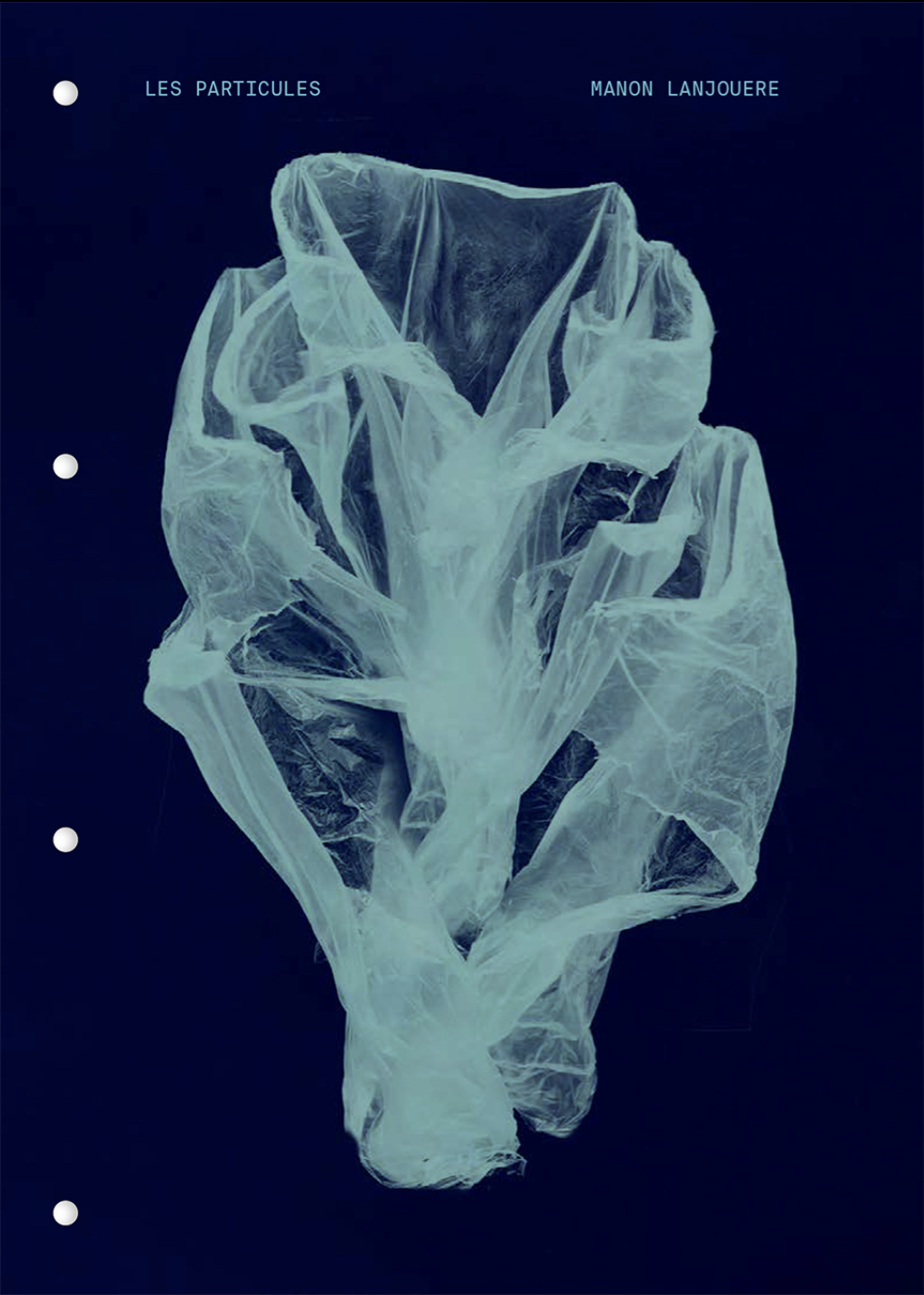
Les Particules, le conte humain d’une eau qui meurt
Images I Manon Lanjouère
Preface I Michel Poivert
Interview I Manon Lanjouère & Ika Paul-Pont conducted by Andreina de Bei
Languages I French, English
Graphic design I Sarah Boris Studio
Collection I Civis Maritimus
Format I 20 x 28 cm, 56 pages, SoftCover, OTAbind
Price I 35€
Buy your copy

Press
Entretien avec Bruno Dubreuil, Viens Voir, 20 mars 2024


Pour la Science n°556 février 2024, p84-87
par Loïc Mangin
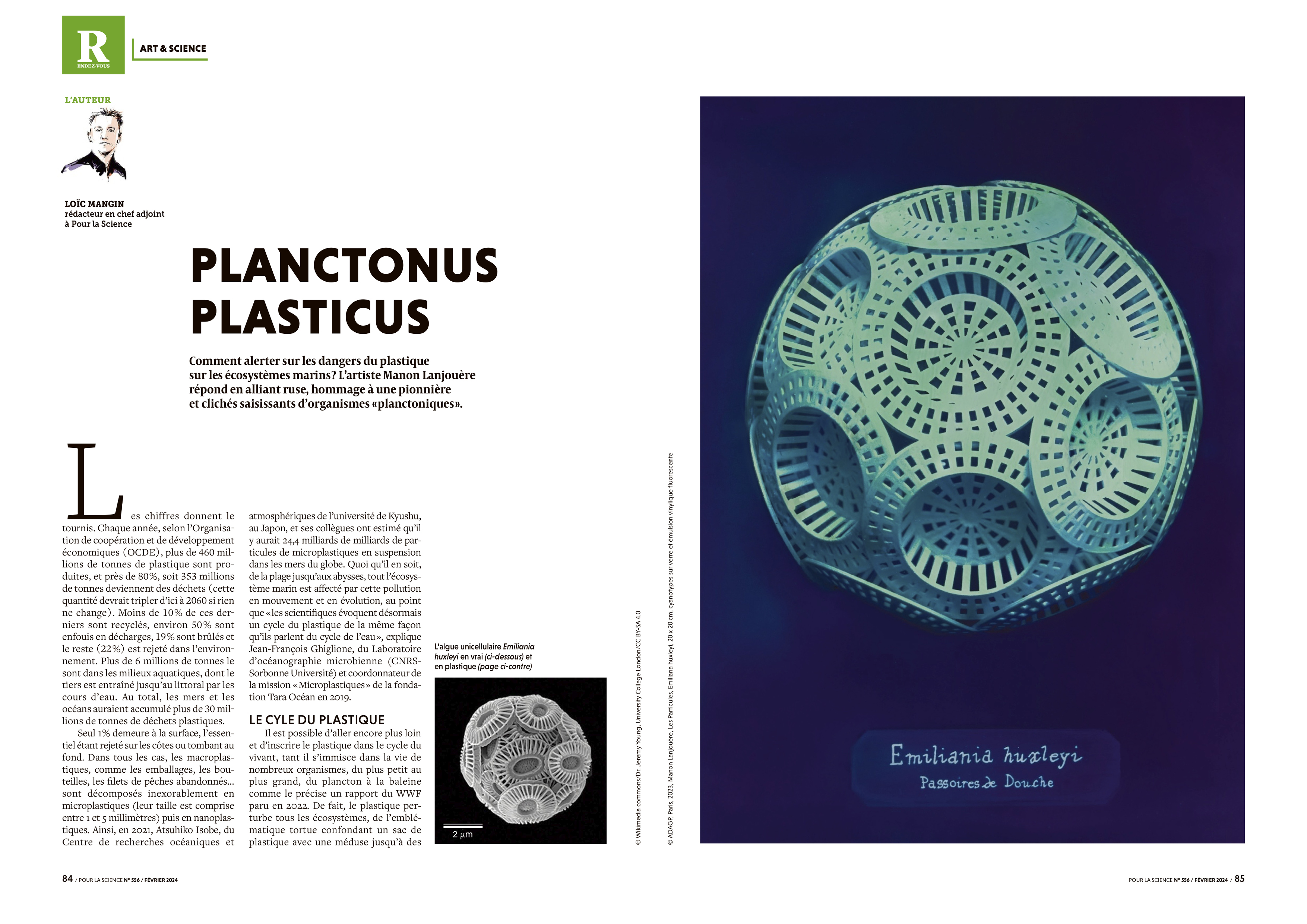
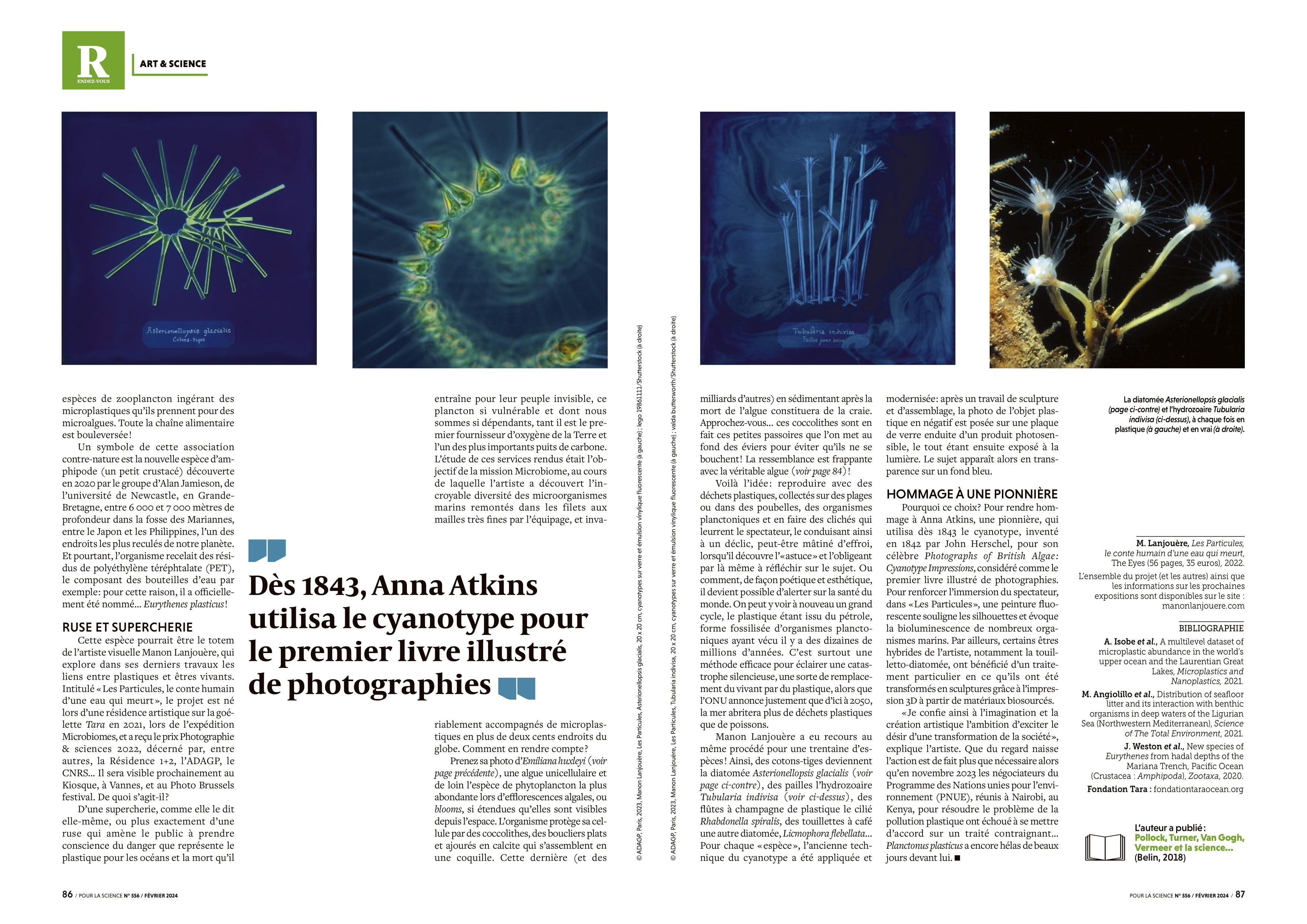
Réponse Photo décembre 2023, p125
![]()
POLLUTION PLASTIQUE
Il ne faut pas juger un livre à sa pagination. Malgré ses 52 pages, cet ouvrage en dit long sur la santé de notre monde et en particulier sur la pollution qui touche nos océans. Ce manifeste poétique est la première publication de la collection «Civis Maritimus» des éditions The Eyes, qui fera paraître une fois par an un ouvrage photographique sur la relation entre l’humain et le monde marin. Et pour ce premier opus, la photographe française Manon Lanjouère s’inspire des herbiers en cyanotype chers à Anna Atkins pour représenter la pollution plastique qui intoxique nos océans. Elle se sert des déchets pour reproduire les espèces en voie d’extinction.
PLASTIC POLLUTION
You shouldn't judge a book by its page count. Despite its 52 pages, this book says a lot about the health of our world and in particular the pollution affecting our oceans. This poetic manifesto is the first publication in the "Civis Maritimus" series from The Eyes, which will publish a photographic work on the relationship between humans and the marine world once a year. For this first opus, French photographer Manon Lanjouère takes her inspiration from the cyanotype herbariums so dear to Anna Atkins to depict the plastic pollution that is poisoning our oceans. She uses rubbish to reproduce endangered species.
Les Particules, de Manon Lanjouère, éd The Eyes 20x2+8cm, 52p, 35 €
E.W
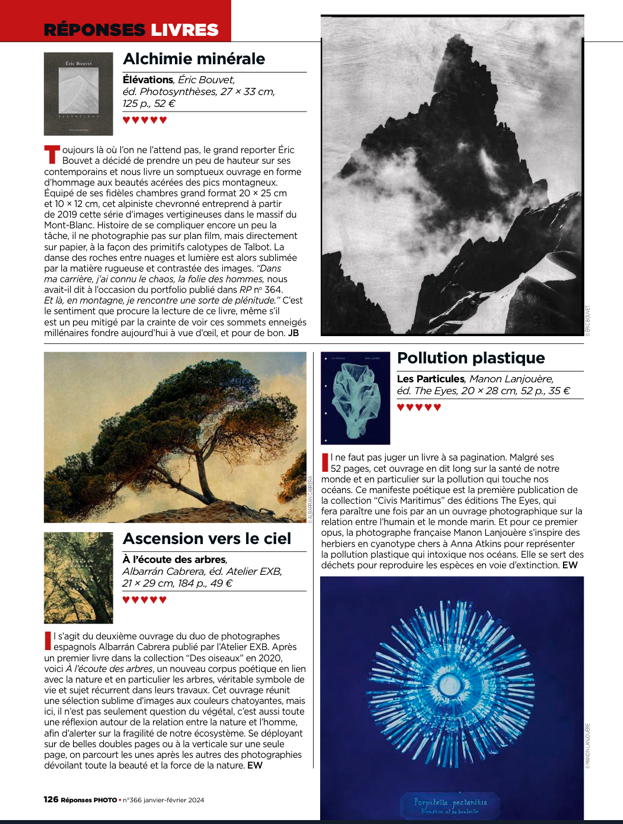
POLLUTION PLASTIQUE
Il ne faut pas juger un livre à sa pagination. Malgré ses 52 pages, cet ouvrage en dit long sur la santé de notre monde et en particulier sur la pollution qui touche nos océans. Ce manifeste poétique est la première publication de la collection «Civis Maritimus» des éditions The Eyes, qui fera paraître une fois par an un ouvrage photographique sur la relation entre l’humain et le monde marin. Et pour ce premier opus, la photographe française Manon Lanjouère s’inspire des herbiers en cyanotype chers à Anna Atkins pour représenter la pollution plastique qui intoxique nos océans. Elle se sert des déchets pour reproduire les espèces en voie d’extinction.
PLASTIC POLLUTION
You shouldn't judge a book by its page count. Despite its 52 pages, this book says a lot about the health of our world and in particular the pollution affecting our oceans. This poetic manifesto is the first publication in the "Civis Maritimus" series from The Eyes, which will publish a photographic work on the relationship between humans and the marine world once a year. For this first opus, French photographer Manon Lanjouère takes her inspiration from the cyanotype herbariums so dear to Anna Atkins to depict the plastic pollution that is poisoning our oceans. She uses rubbish to reproduce endangered species.
Les Particules, de Manon Lanjouère, éd The Eyes 20x2+8cm, 52p, 35 €
E.W
Polka Magazine, novembre 2023, p50
![]()
MANON LANJOUÈRE
TAXONOMOE SOUS-MARINE
Pionnière du cyanotype à l’époque victorienne, la botaniste Anna Atkins se retournerait peut-être dans sa tombe en découvrant la taxonomie du XXe siècle... Pour sensibiliser à la pollution marine, m’artiste bretonne Manon Lanjouère, née en 1993, a transformé une sélection de déchets déversés dans les océans en créatures bioluminescentes. Dans cet étrange catalogue, Cotons-Tiges, pots de yaourt et stylos à bille en état de dégradation avancée apparaissent tels les ennemis mortels de notre écosystème : des microparticules de plastique. Invisibles à l’oeil nu, ils envahissent dans une discrétion parfaite les fonds marins, tuant à petit feu le plancton, premier maillon de la chaîne alimentaire. Aux frontières de l’imagination et de la science, une intrigante vision de l’enfer sous-marin.
MANON LANJOUÈRE
UNDERWATER TAXONOMY
A pioneer of the cyanotype in the Victorian era, botanist Anna Atkins might well be turning over in her grave when she discovers the taxonomy of the 20th century... To raise awareness of marine pollution, Breton artist Manon Lanjouère, born in 1993, has transformed a selection of rubbish dumped in the oceans into bioluminescent creatures. In this strange catalogue, cotton buds, yoghurt pots and ballpoint pens in an advanced state of decay appear as the mortal enemies of our ecosystem: plastic microparticles. Invisible to the naked eye, they invade the seabed with perfect discretion, slowly killing plankton, the first link in the food chain. On the frontiers of imagination and science, an intriguing vision of underwater hell.
Les Particules, de Manon Lanjouère, éd The Eyes, 56p, 35 €
B. M
MANON LANJOUÈRE
TAXONOMOE SOUS-MARINE
Pionnière du cyanotype à l’époque victorienne, la botaniste Anna Atkins se retournerait peut-être dans sa tombe en découvrant la taxonomie du XXe siècle... Pour sensibiliser à la pollution marine, m’artiste bretonne Manon Lanjouère, née en 1993, a transformé une sélection de déchets déversés dans les océans en créatures bioluminescentes. Dans cet étrange catalogue, Cotons-Tiges, pots de yaourt et stylos à bille en état de dégradation avancée apparaissent tels les ennemis mortels de notre écosystème : des microparticules de plastique. Invisibles à l’oeil nu, ils envahissent dans une discrétion parfaite les fonds marins, tuant à petit feu le plancton, premier maillon de la chaîne alimentaire. Aux frontières de l’imagination et de la science, une intrigante vision de l’enfer sous-marin.
MANON LANJOUÈRE
UNDERWATER TAXONOMY
A pioneer of the cyanotype in the Victorian era, botanist Anna Atkins might well be turning over in her grave when she discovers the taxonomy of the 20th century... To raise awareness of marine pollution, Breton artist Manon Lanjouère, born in 1993, has transformed a selection of rubbish dumped in the oceans into bioluminescent creatures. In this strange catalogue, cotton buds, yoghurt pots and ballpoint pens in an advanced state of decay appear as the mortal enemies of our ecosystem: plastic microparticles. Invisible to the naked eye, they invade the seabed with perfect discretion, slowly killing plankton, the first link in the food chain. On the frontiers of imagination and science, an intriguing vision of underwater hell.
Les Particules, de Manon Lanjouère, éd The Eyes, 56p, 35 €
B. M
9 lives, 22 novembre 2023
![]()
Les particules, livre de la photographe Manon Lanjouère, paru chez The Eyes est le récit glaçant d’une catastrophe silencieuse. Sous-titré Le conte humain d’une eau qui meurt, il se présente sous forme d’un cahier aux feuilles détachables et perforées, comme si le lecteur voulait ensuite archiver chacune d’elles dans un classeur. Sur chaque feuille un cyanotype représente une forme semblable à un organisme vivant, sous laquelle apparaissent une inscription latine ressemblant à une classification scientifique et une inscription en français donnant le nom de l’objet originel.
Ainsi le lecteur croisera : Stephanopyxis palmeriana qui est en fait des filtres de cigarettes en stick, Guinardia striata un élastique à cheveux ou Thalassiosira lentiginosa un plateau pour galettes. Le point commun de chacun d’entre eux ? Ils sont en plastique jetable et de fait non-recyclé.
Dans un texte initial Michel Poivert écrit « Elle (la photographie) est l’art du futur disparu ». Et de fait, Les particules porte en lui la chronique d’un monde qui se meurt. Manon Lanjouère a démarré ce projet lors d’un séjour sur la goélette scientifique Tara. Alors que les scientifiques étudiaient les vies sous-marines invisibles à l’œil nu (le plancton), la photographe a croisé cette étude avec le fait qu’à très court terme il y aurait plus de plastique dans les mers et océans du globe que de poissons. Cette pollution, en partie invisible, représente une menace plus que grave pour la survie des espèces du globe, dont la nôtre.
En effet, la vie des fonds sous-marin, mais aussi la vie terrestre sont assurées par la photosynthèse que réalisent ces organismes. Or, que va-t-il se passer dans un futur proche ? Nos plastiques, bien trop nombreux, vont prendre toute la place, obérant ainsi la possibilité de photosynthèse. Il y a aura plus de CO2, moins d’oxygène et donc mécaniquement une aggravation brutale des conditions de vie (accélération du dérèglement climatique notamment).Les « objets-êtres » que réalise Manon Lanjouère, qu’elle photographie, ont quelque chose de fascinant. Au-delà de l’aspect documenté, scientifique du travail, ils révèlent une sorte de beauté glaçante. Les brosses à cheveux deviennent des êtres aux pattes multiples, qu’on imagine se déplaçant sur les fonds marins à la recherche de proies, scolopendres foudroyants des récifs coraliens. Nos stylos à billes, ces Bic dont on se saisit machinalement, se transforment en vers ondulants aux formes anguleuses. Tout ressemble ici à la Vie, alors que ce ne sont que des objets inertes n’ayant même jamais eu une âme.Mais hélas, l’Homme est trop souvent un Saint Thomas atteint de cécité qui refuse de voir ce qui est sous son nez. Les scientifiques, certains médias, attirent sans cesse l’attention sur ces plastiques à usage unique et sur leurs dangers. Pour le moment on se contente d’interdire les touillettes dans les machines à café… Pourtant, les risques évoqués plus haut sont bien réels ! Les créatures présentées dans Les Particules sont une autre façon de nous dire attention ! Manon Lanjouère, dans une interview publiée dans la seconde partie du livre, mais aussi dans des textes qui suivent, ne cesse de le rappeler. Le Beau s’il est toujours bizarre, peut aussi être mortel. Et c’est cette dichotomie image/réalité qui saisit le lecteur. Il n’y a rien d’anodin dans nos modèles de consommation, il n’y a rien d’anodin que Apolernia lanosa soit constitué de guirlandes de Noël. Il n’y a rien d’anodin dans ce plastique crée à partir de pétrole, il n’y a rien d’anodin que des bouchons pour flacons de sauce hantent les algues et les coraux.Alors que faire ? La photographe se garde de donner des réponses catégoriques et forcément partielles. Mais cette dystopie photographique laisse tout de même penser que modifier nos modes de consommation serait de la plus extrême urgence. L’écologie au sens large n’est pas affaire que des politiques, des puissants (même s’ils devraient en faire un peu plus leur affaire), elle est aussi du ressort du citoyen lambda. Consommons moins, mieux, cessons cet usage effréné du tout jetable afin d’éviter qu’un jour ces créatures étranges ne deviennent plus que la seule forme de vie que nous connaîtrons.
Les particules sonne comme un cri d’alarme qu’il faut entendre rapidement.
Frédéric Martin
![]()

Les particules, livre de la photographe Manon Lanjouère, paru chez The Eyes est le récit glaçant d’une catastrophe silencieuse. Sous-titré Le conte humain d’une eau qui meurt, il se présente sous forme d’un cahier aux feuilles détachables et perforées, comme si le lecteur voulait ensuite archiver chacune d’elles dans un classeur. Sur chaque feuille un cyanotype représente une forme semblable à un organisme vivant, sous laquelle apparaissent une inscription latine ressemblant à une classification scientifique et une inscription en français donnant le nom de l’objet originel.
Ainsi le lecteur croisera : Stephanopyxis palmeriana qui est en fait des filtres de cigarettes en stick, Guinardia striata un élastique à cheveux ou Thalassiosira lentiginosa un plateau pour galettes. Le point commun de chacun d’entre eux ? Ils sont en plastique jetable et de fait non-recyclé.
Dans un texte initial Michel Poivert écrit « Elle (la photographie) est l’art du futur disparu ». Et de fait, Les particules porte en lui la chronique d’un monde qui se meurt. Manon Lanjouère a démarré ce projet lors d’un séjour sur la goélette scientifique Tara. Alors que les scientifiques étudiaient les vies sous-marines invisibles à l’œil nu (le plancton), la photographe a croisé cette étude avec le fait qu’à très court terme il y aurait plus de plastique dans les mers et océans du globe que de poissons. Cette pollution, en partie invisible, représente une menace plus que grave pour la survie des espèces du globe, dont la nôtre.
En effet, la vie des fonds sous-marin, mais aussi la vie terrestre sont assurées par la photosynthèse que réalisent ces organismes. Or, que va-t-il se passer dans un futur proche ? Nos plastiques, bien trop nombreux, vont prendre toute la place, obérant ainsi la possibilité de photosynthèse. Il y a aura plus de CO2, moins d’oxygène et donc mécaniquement une aggravation brutale des conditions de vie (accélération du dérèglement climatique notamment).Les « objets-êtres » que réalise Manon Lanjouère, qu’elle photographie, ont quelque chose de fascinant. Au-delà de l’aspect documenté, scientifique du travail, ils révèlent une sorte de beauté glaçante. Les brosses à cheveux deviennent des êtres aux pattes multiples, qu’on imagine se déplaçant sur les fonds marins à la recherche de proies, scolopendres foudroyants des récifs coraliens. Nos stylos à billes, ces Bic dont on se saisit machinalement, se transforment en vers ondulants aux formes anguleuses. Tout ressemble ici à la Vie, alors que ce ne sont que des objets inertes n’ayant même jamais eu une âme.Mais hélas, l’Homme est trop souvent un Saint Thomas atteint de cécité qui refuse de voir ce qui est sous son nez. Les scientifiques, certains médias, attirent sans cesse l’attention sur ces plastiques à usage unique et sur leurs dangers. Pour le moment on se contente d’interdire les touillettes dans les machines à café… Pourtant, les risques évoqués plus haut sont bien réels ! Les créatures présentées dans Les Particules sont une autre façon de nous dire attention ! Manon Lanjouère, dans une interview publiée dans la seconde partie du livre, mais aussi dans des textes qui suivent, ne cesse de le rappeler. Le Beau s’il est toujours bizarre, peut aussi être mortel. Et c’est cette dichotomie image/réalité qui saisit le lecteur. Il n’y a rien d’anodin dans nos modèles de consommation, il n’y a rien d’anodin que Apolernia lanosa soit constitué de guirlandes de Noël. Il n’y a rien d’anodin dans ce plastique crée à partir de pétrole, il n’y a rien d’anodin que des bouchons pour flacons de sauce hantent les algues et les coraux.Alors que faire ? La photographe se garde de donner des réponses catégoriques et forcément partielles. Mais cette dystopie photographique laisse tout de même penser que modifier nos modes de consommation serait de la plus extrême urgence. L’écologie au sens large n’est pas affaire que des politiques, des puissants (même s’ils devraient en faire un peu plus leur affaire), elle est aussi du ressort du citoyen lambda. Consommons moins, mieux, cessons cet usage effréné du tout jetable afin d’éviter qu’un jour ces créatures étranges ne deviennent plus que la seule forme de vie que nous connaîtrons.
Les particules sonne comme un cri d’alarme qu’il faut entendre rapidement.
Frédéric Martin

Podcast
Pour ce deuxième épisode de The Eyes Talks, nous avons invité Manon Lanjouère à nous parler de son livre Les Particules, le conte humain d'une eau qui meurt publié en octobre 2023.
Les Particules, conte humain d’une eau qui meurt, un manifeste poétique et photographique en faveur de la préservation des océans. Ce livre invite, par une approche poétique et artistique, à une réflexion profonde sur la pollution des océans. Chaque image, par sa beauté plastique, invite à la contemplation mais aussi, par sa force visuelle, à l’action. Un livre qui témoigne de la puissance de la création artistique dans sa capacité à transformer la société.
Pour ce deuxième épisode de The Eyes Talks, nous avons invité Manon Lanjouère à nous parler de son livre Les Particules, le conte humain d'une eau qui meurt publié en octobre 2023.
Les Particules, conte humain d’une eau qui meurt, un manifeste poétique et photographique en faveur de la préservation des océans. Ce livre invite, par une approche poétique et artistique, à une réflexion profonde sur la pollution des océans. Chaque image, par sa beauté plastique, invite à la contemplation mais aussi, par sa force visuelle, à l’action. Un livre qui témoigne de la puissance de la création artistique dans sa capacité à transformer la société.
Residency on board schooner Tara
After a month on board the scientific schooner Tara between Salvador and Rio de Janeiro to observe research on microbiomes, my year 2022 has been occupied with the realization of my project entitled Les Particules which proposes to shed light on the plastic pollution of the ocean and its impact on microorganisms.
click here to listen the podcast on my experience on board ︎ (french)
After a month on board the scientific schooner Tara between Salvador and Rio de Janeiro to observe research on microbiomes, my year 2022 has been occupied with the realization of my project entitled Les Particules which proposes to shed light on the plastic pollution of the ocean and its impact on microorganisms.
click here to listen the podcast on my experience on board ︎ (french)
